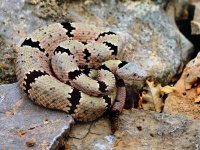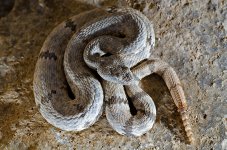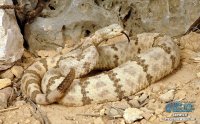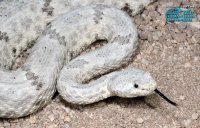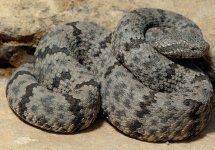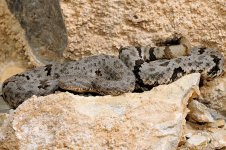Click on a picture to see a larger version in a different window
| Range: |
 |
| Other Names: |
Blue Rattlesnake, Green Rattlesnake, Green Rock Rattlesnake, eastern rock rattlesnake, little green rattlesnake, pink rattlesnake, Texas rock rattlesnake, and white rattlesnake. |
| Subspecies: |
Banded Rock Rattlesnake Crotalus lepidus klauberi Dark body bands distinct and widely spaced, contrasting with bluish green or greenish (males) or bluish gray (females) ground color. Spaces between bands moderately dark-spottedor unspotted. No dark stripe from eye to corner of mouth.
Mottled Rock Rattlesnake Crotalus lepidus lepidus Dusky overall, but sometimes quite pale, with fading of blotches, especially anteriorly. Considerable dark spotting between dark body bands, sometimes forming additionalbands between primary ones. Dark stripe extends from eye to corner of mouth. |
| Description: |
A small rattlesnake, 15"- 33" in. Rock Rattlesnakes can be distinguished most readily by the conspicuous dark crossbars on the body. These crossbars may be evident throughout the length of the body or only posteriorly.The dark stripe from the eye to the corner of the mouth may or may not be evident. The tail is
bright yellow in juvenile animals and becomes salmon in adults. |
| Venom: |
Venom is medically significant |
| Habitat: |
Inhabits many of the extreme desert mountain ranges in southern New
Mexico. Found at elevations ranging from about 4,000' to 8,500'. A
snake that frequents rocky terrain, large rock outcroppings, rocky
stream beds, and steep rocky talus slopes in evergreen woodland and
montane conifer forests. Basks in open rocky areas in forests near
permanent and intermittent springs or streams. |
| Behavior: |
Chiefly diurnal but can be active at night in warmer months. |
| Hibernation: |
Known to hibernate in deep cracks, sometimes in communal dens. Have been found hibernating with Western Diamondbacks (C. atrox) and Blacktail Rattlesnake (C. molossus and C. ornatus) |
| Reproduction: |
Livebearing,
gives live birth 2-9 young in late summer. |
| Diet: |
Young may feeds on insects, Adults eat mice, frogs, lizards, and birds |
Authored by: Garth Teitjen
Sources:


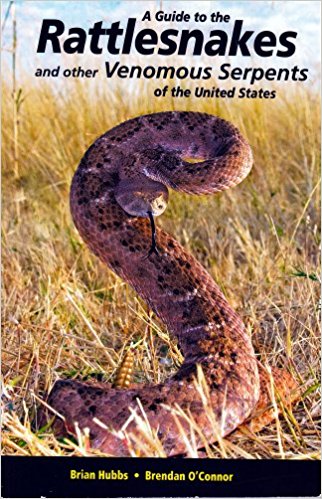

|







